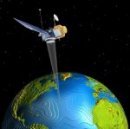The new challenge
P.Y. Le Traon (CLS, France)

TOPEX/POSEIDON data is now routinely available:
the data is validated and distributed to the scientific community within a month of being gathered. More than 650 days of data-65 cycles-have been made available. Verification has now fortunately given way to scientific interpretation.
This third AVISO Newsletter is therefore mainly about scientific applications of the TOPEX/POSEIDON mission.
Some of the results you can read about are spectacular. Thanks to TOPEX/POSEIDON we have monitored the current El Niño event and equatorial wave activity and observed the long-wavelength variability of the ocean for the first time. Mean sea level can be measured to within a few millimeters! TOPEX/POSEIDON data, combined with in situ measurements from TOGA and WOCE or assimilated in numerical models, can also yield accurate descriptions of 3D circulation. The extraordinary accuracy of TOPEX/POSEIDON measurements is taking us significantly further in our knowledge of the ocean and its role in the climate.
Those of us working on AVISO must also go on working to improve data quality, and more generally the service to users. This will mean constant interaction with the scientific community. We know, for example, that ocean tides are the main source of error in TOPEX/ POSEIDON measurements, but also that TOPEX/POSEIDON can estimate them to centimeter accuracy. The new tide models from AVISO will considerably improve data quality. The purpose of CLS validation includes enhancing data quality and advising users on how to use the data.
But it's already time to look ahead. Satellite altimetry is an essential component of the long-term ocean observing system now being set up. We will soon need homogeneous, validated data from the different altimeter missions. The new challenge is a multi-mission processing system. The pilot experiment on ERS-1 and TOPEX/ POSEIDON data is a start. It means a lot of work, but there's no way around it. By year 2000, we need to be able to homogeneously process data from TOPEX/POSEIDON, ERS-1, ERS-2, Envisat, Geosat Follow-on and TOPEX/POSEIDON Follow-on. We also need to provide scientific users with more sophisticated, directly useable products, such as for operational assimilation in models. We must also promote the use of altimetric data for non-altimetry specialists, such as the broad oceanographic community. This is one of the objectives of the Centre for Earth Observation (CEO) being set up in Europe. The new challenge is for the whole oceanographic community.




